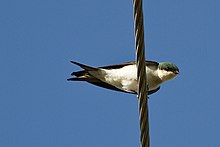Bahama swallow
| Bahama swallow | |
|---|---|

| |
| Scientific classification | |
| Domain: | Eukaryota |
| Kingdom: | Animalia |
| Phylum: | Chordata |
| Class: | Aves |
| Order: | Passeriformes |
| Family: | Hirundinidae |
| Genus: | Tachycineta |
| Species: | T. cyaneoviridis |
| Binomial name | |
| Tachycineta cyaneoviridis (Bryant, 1859) | |

| |
| Synonyms[2] | |
| |
The Bahama swallow (Tachycineta cyaneoviridis) is an endangered swallow endemic to The Bahamas.
Description
This glossy Tachycineta swallow has a green head and back, blue upper wings, a black tail and wingtips, and a white belly and chin.
Distribution and habitat
This swallow breeds only in pineyards on four islands in the northern Bahamas: Andros, Grand Bahama, Abaco, and New Providence.[3] The breeding population on New Providence is, at the very least, greatly reduced from historical levels, and may be extirpated as a breeding species.[4]
The Bahama swallow winters throughout the eastern Bahamas and the Turks and Caicos Islands.[4] It is a rare vagrant elsewhere during migration, including south Florida, the Florida Keys and Cuba.[5] It is also an occasional vagrant to South America.[6]
T. cyaneoviridis is endemic to the Bahamian pineyards, though they are somewhat capable of adapting to urban habitat. Although they do not breed in marshland and fields, they need such habitat to forage; like all swallows, they feed on flying insects.
Reproduction
Bahama swallows nest in old West Indian woodpecker (Melanerpes superciliaris) holes in Caribbean pine (Pinus caribaea var. bahamensis), using pine needles, twigs of trees from the genus Casuarina (introduced species in the Bahamas), and grass to make the nest, and they line it with feathers from other passerines. They typically lay three eggs. Incubation is 15 days and the fledging period is roughly 22 days.[3]
References
- ^ BirdLife International (2020). "Tachycineta cyaneoviridis". IUCN Red List of Threatened Species. 2020: e.T22712080A179692086. doi:10.2305/IUCN.UK.2020-3.RLTS.T22712080A179692086.en. Retrieved 12 November 2021.
- ^ "Tachycineta cyaneoviridis (H.Bryant, 1859)". Global Biodiversity Information Facility. Retrieved 12 February 2023.
- ^ a b Allen, P (1996). "Breeding biology and natural history of the Bahama Swallow" (PDF). The Wilson Bulletin. 108 (3): 480–495. JSTOR 4163715. Retrieved 12 February 2023 – via Searchable Ornithological Research Archive, University Libraries, University of New Mexico.
- ^ a b BirdLife International (2023). "Species factsheet: Tachycineta cyaneoviridis". BirdLife International. Retrieved 12 February 2023.
- ^ American Ornithologists Union, (1998): Check-list of North American Birds. 7th edition. American Ornithologists Union, Washington, D.C.
- ^ Strewe, R. (2006). "Primer registro de la Golondrina de Bahamas Tachycineta cyaneoviridis para Suramérica" [First record of the Bahama Swallow T. cyaneoviridis for South America] (PDF). Boletín de la Sociedad Antioqueña de Ornitología (in Spanish). 16 (1): 54–58. Retrieved 12 February 2023 – via Sociedad Antioqueña de Ornitología.

